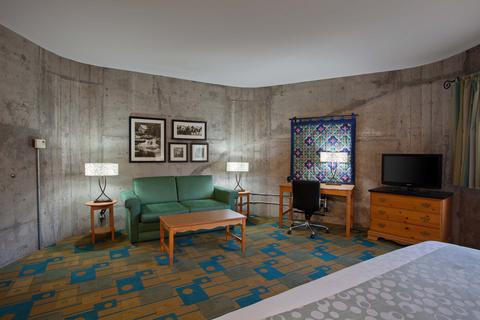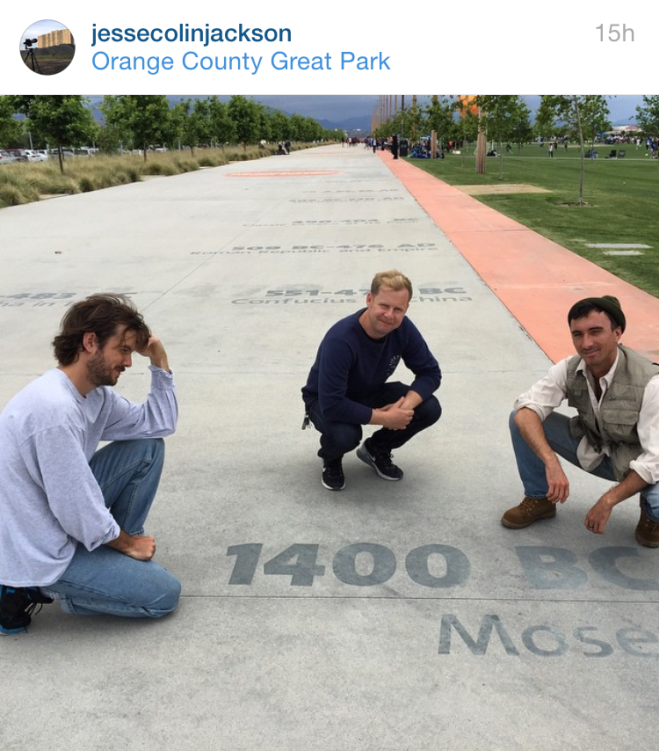On Saturday, May 23rd UCI professor Jesse Colin Jackson, grad students Conor Thompson, Jason Gowans and Maura Murnane, and myself participated in a tour of South Orange County which we dubbed the “OC Flaneur Day, pt.I”. The tour had no guide and no set itinerary other than to experience some unique Orange County environments and to end the day around cocktails.
We began with the post-modern shopping experience of the Irvine Spectrum, a spiral turned in upon itself where one is able to seamlessly walk through the development’s 10 year history, from the Moorish literalisms of its initial phase, on through to the deco bombast of its 21 screen theater, the French colonialism of its late-90’s expansion and finally the corporate efficiency of its most recent structures – terracota rectangles housing Tender Greens and Laugh Factories. Irvine Spectrum, in its scale, walkability and construction, allows the visitor the unique experience of guiding oneself on a tour of the economic forces which often define the modern, exurban landscape. The initial phase of development employed a great deal of ornamentation and architectural seduction in order to establish a strong sense of place that would carry the center above the host of nearby shopping centers vying for the same consumer base. Comparisons can be drawn to the early suburban communities of Naples in Seal Beach or even China’s Tianducheng. As you move through the mall, and therefore move through time, you witness a lessening of details, an architectural regression toward the banal until finally you are in front of the Spectrum’s most recent structures, stucco cubes too unimaginative to beguile and too ornamented with the functions of commerce to qualify as minimalist. Less Tianducheng and more Pheonix, AZ. And stultifying as that conclusion may be, the pleasures of psychically traversing such a distance, with the chance to grab a coffee in between, was enjoyed by all.
Our next stop was a time traveling of the more conventional sort, the Sack Warehouse, built in 1895, making it Irvine’s oldest remaining building. Now home to a tech company, an architect’s office and a Jiu-Jitsu studio and a La Quinta Inn. The adaptive reuse by La Quinta in particular has resulted in a deliciously unsure mishmash of aesthetics both austerely industrial and blandly corporate, like a Madonna Inn suite fashioned in tribute to an Eli Roth torture flick, as evidenced by this stock photo of the hotel’s interior:
 From the La Quinta it was a short drive to our next destination, Irvine’s Great Park. Conceived in 2001, only a sliver of the original park design is currently operational and open to the public while politicians, real estate developers and activists tussle over the fate of the remaining acreage. After parking amidst the soccer-mom SUV’s and upmarket RV’s tailgating the youth soccer games taking place on the park’s sport fields, we entered the Palm Court Arts Complex, an evenly spaced and orderly grid of phoenix canariensis palm trees set against pastel checkerboard flooring and a quaint collection of WWII military barracks left over from the park’s previous life as an Air Force Base. We were drawn a nearby building by a sign advertising open studios, but found instead the “Gloomy Day Theater”, a children’s puppet show. Continuing on towards the reflecting pools we walked down a former airstrip now converted into a “Walkable Historical Timeline” – a pedestrian boulevard punctuated with important dates and events like “1870 AD : Standard Oil is incorporated” and “1400 BC : Moses”.
From the La Quinta it was a short drive to our next destination, Irvine’s Great Park. Conceived in 2001, only a sliver of the original park design is currently operational and open to the public while politicians, real estate developers and activists tussle over the fate of the remaining acreage. After parking amidst the soccer-mom SUV’s and upmarket RV’s tailgating the youth soccer games taking place on the park’s sport fields, we entered the Palm Court Arts Complex, an evenly spaced and orderly grid of phoenix canariensis palm trees set against pastel checkerboard flooring and a quaint collection of WWII military barracks left over from the park’s previous life as an Air Force Base. We were drawn a nearby building by a sign advertising open studios, but found instead the “Gloomy Day Theater”, a children’s puppet show. Continuing on towards the reflecting pools we walked down a former airstrip now converted into a “Walkable Historical Timeline” – a pedestrian boulevard punctuated with important dates and events like “1870 AD : Standard Oil is incorporated” and “1400 BC : Moses”.

From the Great Park to a great business park, our next stop was the idiosyncratic Muirlands Office Park in East Irvine. Developed in the late 80’s, the 2,200 acre site bucked the trend of office parks built with repeating architectural patterns, opting for a more luxuriant and enjoyable collection of architecturally unique structures, their strong minimalist forms fleshed out in aluminum, concrete and teak, situated in the familiar environment of manicured landscapes and wide cul-de-sacs. The result landing somewhere between utopian workplace and a large scale sculpture garden.
After that a quick visit to the Oakley Headquarters in Foothill Ranch, a 1-million square foot warehouse outfitted with a massive metallic ‘eye’, dubbed the Oakley Icon, equal parts steampunk fantasy and Giger-esque nightmare. The flaneurs marveled at the structure and explored the grounds, where we found among other things: a large metallic spider, an Oakley branded tank, and in a public gesture uniquely Oakley, a public RC truck obstacle course.
At this point everyone in the group had worked up quite an appetite, so we journeyed into the canyons of the Santa Ana mountains to Cooks Corner, legendary biker bar and swingers spot where you’re more likely to encounter an argument over global interest rates than the kind of fight that precipitated the Waco shootout. We ate our (awful) burgers while NWA “Fuck tha Police” blasted from the jukebox and powered through the rest of our tour before the meal could catch up with us.
From Cook’s Corner it was a short and bucolic drive to Modjeska Canyon, established by Polish film star Helena Modjeska in the late 1800’s, the area maintains the rustic charm that has made California canyon living so desirable since the days Joni Mitchell first picked up a guitar. The town boasts a nature preserve, but it was closed by the time we arrived, and while charming to the gills, Modjeska’s pleasures are mostly reserved for the property owners who reside within it, so we pushed on, winding our way through Santiago Canyon road (dubbed “The Mulholland of the south”) until we reached Black Star Canyon, the site of a good deal of storied killings, hermits and hauntings. Having toured sites equally steeped in both the western dream and the California nightmare, we left Canyon Country for the final leg of the tour.
Mexican architect Ricardo Legorreta is probably best known in the Southland for his widely derided 1994 renovation of Los Angeles’ Pershing Square, but a mall on the southern end of Tustin provides what is possibly the most robust example of the architect’s talents (or lack thereof, depending on your perspective). Even within the group reactions were mixed, but I maintain that the center’s colorful and monumental minimalist forms provide the ideal incubator to Southern California’s car-centric, viewed at 55 mph commercial culture. The group fortified itself on margaritas at the center’s Islands restaurant before visiting the final stop on the day’s tour.
The Tustin Hangars were built in the 1940’s, during WWII. Because of steel rationing during wartime, the structures, twin behemoths built each the length of three football fields, are each self-supporting structures built entirely of concrete and wood. The buildings are Ballardian enough on their own, but since Orange County’s ubiquitous, Medditerrian inspired condo architecture has encroached literally to their doorsteps, the dystopian effect has only deepened in recent times. As the sun set against the hangar doors I recalled to the group the true story of a WWII fighter pilot who crashed into a hangar while the foundations were being poured. Material rationing being what it was at the time the decision was made to continue construction around the corpse where it remains to this day, entombed within the structure, which will soon become a state park.






